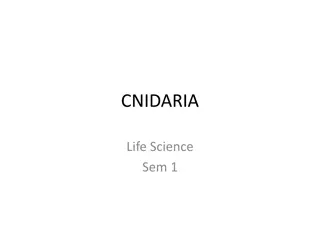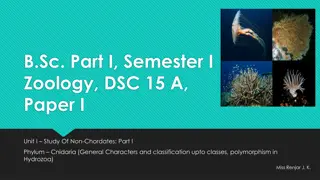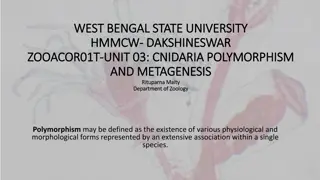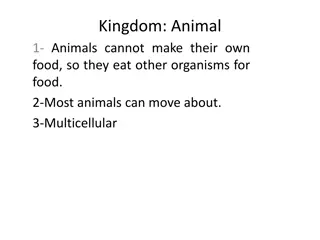Understanding the Unique Features of Phylum Cnidaria in Life Science
Phylum Cnidaria comprises diverse marine animals like jellyfish, sea anemones, corals, and Hydra, exhibiting radially symmetric bodies with unique structures called cnidocytes. These cnidocytes serve as sensory-effector cells that contain specialized stinging organelles called cnidae, aiding in defe
0 views • 7 slides
Exploring Diversity in Porifera and Cnidaria Phyla Through Lab Observations
You were exposed to the wide array of animals in the Porifera and Cnidaria phyla in a lab exercise. Understanding the distinguishing features of each group, their roles in the environment, and the structures crucial for identification is key. Focus on bold-faced structures and labeling on diagrams a
0 views • 12 slides
Study of Phylum Cnidaria: General Characters and Classification
Phylum Cnidaria comprises aquatic organisms with specialized stinging cells known as cnidoblasts. They exhibit radial symmetry and are triploblastic, with distinct polyp and medusa forms. The phylum includes classes like Hydrozoa, Scyphozoa, and Anthozoa, each displaying unique characteristics and m
0 views • 6 slides
Overview of Phylum Cnidaria: Classification and Characteristics
Phylum Cnidaria consists of around 10,000 species classified into 5 classes: Hydrozoa, Anthozoa, Cubozoa, Scyphozoa, and Staurozoa. Each class has unique characteristics and examples, such as the sea serpents in Hydrozoa and flower animals in Anthozoa. Cnidarians exhibit radial or biradial symmetry,
0 views • 16 slides
Understanding Polymorphism and Metagenesis in Cnidaria at West Bengal State University
Polymorphism in cnidarians refers to the presence of diverse physiological and morphological forms within a single species. This phenomenon leads to the specialization and cooperation of zooids in colonial forms, eventually functioning collectively for the colony's benefit. The structural characteri
0 views • 9 slides
Exploring the Characteristics of Phylum Cnidaria
Phylum Cnidaria, derived from the Greek word meaning stinging nettle, encompasses various marine species like jellyfish, sea anemones, and corals. These animals exhibit traits such as being diploblastic, with an ectoderm and endoderm separated by mesogloea. They possess a gastrovascular cavity, nema
0 views • 27 slides
Overview of Animal Kingdom's Phyla and Characteristics
Animals in the Kingdom Animalia have diverse characteristics and are classified into different phyla based on specific traits and features. This includes Porifera (sponges), Cnidaria (jellyfishes), Platyhelminthes (flatworms), Nematoda (roundworms), Annelida (earthworms), Mollusca (snails, octopus),
0 views • 10 slides






